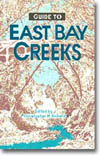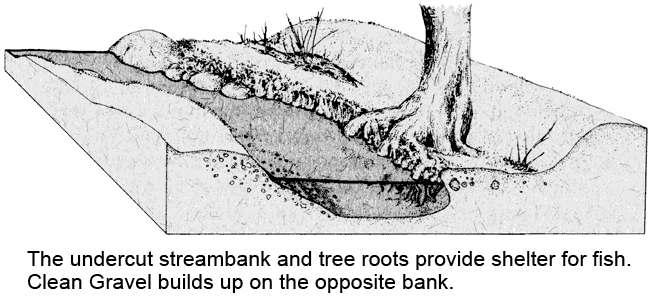GUIDE TO EAST BAY CREEKS
Chapter Five
Living in the System
 To many people who dream of restoring the East Bay creeks, the pinnacle of their aspirations is returning steelhead and salmon to the streams. These fish embody food, recreation, and aesthetic delight in one silver parcel of determination and energy. However, their return requires much more than stocking them in the stream, and represents much more than adding one species to the fish community. Certain other native fishes, riparian plants, and aquatic insects could be reintroduced and artificially maintained in small islands of restored creek habitat within an otherwise culverted stream. But the seagoing habits of the steelhead and salmon demand an intact stream system. And their migrations reveal that the system is not just the local stream, but everything between the watershed boundaries in our hills and the Gulf of Alaska.
To many people who dream of restoring the East Bay creeks, the pinnacle of their aspirations is returning steelhead and salmon to the streams. These fish embody food, recreation, and aesthetic delight in one silver parcel of determination and energy. However, their return requires much more than stocking them in the stream, and represents much more than adding one species to the fish community. Certain other native fishes, riparian plants, and aquatic insects could be reintroduced and artificially maintained in small islands of restored creek habitat within an otherwise culverted stream. But the seagoing habits of the steelhead and salmon demand an intact stream system. And their migrations reveal that the system is not just the local stream, but everything between the watershed boundaries in our hills and the Gulf of Alaska.
During the era of the Works Progress Administration (WPA) and post-war fisheries improvement projects, the approach was to identify specific problems in the stream and attack them directly. If the problem was erosion, build a check dam; lack of spawning habitat, dump in some gravel. However, habitat improvement and flood control efforts alike regularly failed to achieve the desired results because they did not account for the dynamic nature of streams. Faced with these failures, those working in fisheries enhancement were forced to turn toward watershed restoration. In doing so over the past few decades, they developed an integrated, or systems, view of creeks and rivers.
Once the goal of restoring a stream system, rather than a fish population, is shouldered, the complex nature of stream systems reveals itself. A stream system is more than the sum of its parts, so restoring missing parts is an incomplete solution. The system incorporates the stream's water and streambed, its watershed, plant and animal inhabitants, the physical and biological processes by which they all interact, its history and future, and even global processes such as tectonics and climate change.

Processes are major, if less tangible, features of a stream system. Streams have no optimal flow; rather, flows must fluctuate season to season and year to year. Artificial stabilization of meanders does not suffice. The meanders must be free to traverse the flood plain slowly. Simply put, the stream must be brought back to a state where it produces its own missing parts.
The most basic processes of a stream system are the cyclical changes in its water flow. These flow cycles are the most important aspect of the long-term health of a stream and are, unfortunately, the most threatening to the personal property of those inhabiting the flood plain.
Streams produce a streambed whose cross-section reflects the flow regime. Usually the stream flow is low and held within the banks of the main channel. But this flow does little to maintain the long-term health of the system, other than keeping things watered.
When major floods occur, the stream overtops the banks and inundates the alluvial plain. These floods redistribute sediments, trees, crops, houses, or anything else in the way. As the stream recedes, it deposits rich sediments on the flood plain and returns to the main channel, which is often realigned. Streamside trees such as willows and cottonwoods require these barren sediment deposits for their seeds to sprout.
Medium floods deposit sediment forming natural levees, further enclosing normal stream flows within the channel. They also cue the upstream spawning migration of salmon, steelhead, and other fishes.
During small floods, the stream eats away at its banks, forming S-shaped meanders across the flood plain. In doing so, the stream organizes itself into an alternating series of pools and riffles. The pools stabilize where tree roots slow the erosion, thereby creating cool, shady shelter for young fish. The meandering stream also deposits clean gravels in the riffles and point bars — gravels that provide spawning habitat during high winter and spring flows.

Thus, each stage of a stream system's flow regime plays a critical role in maintaining the balance and organization of its biological and geological components. Recognition of the stream's inherent competence to manage
its own affairs is prompting us to reexamine the practice of trying to enhance fisheries or control floods by erecting man-made structures.
Enter civilization. Because floodplains are fertile, there we sow our crops. Because they are flat, there we build our houses. The nearer the stream, the more the trees shelter us in winter and shade us in summer. The nearer the stream, the shorter the drain to carry away our wastes. The nearer the stream, the higher the property values and insurance premiums.
To protect our property we build dams to suppress the floods and higher levies to constrain the flows, and we straighten the meanders to speed drainage. To prevent street flooding we build storm drains directing runoff into the channelized creeks. In our sloth and ignorance we dump used motor oil and leftover pesticides into these storm drains, and thus into the creeks. Yet we yearn for the silver parcels of determination and energy, the fish of our streams. We yearn for the trees, pools, and riffles.
How will we improve the stewardship of our resources? What goals will our society set? What trade-offs will we make? The answers will come in the future, but for our creeks, the future begins now — with your actions.
--Christopher Richard & Sarah Pollock
Chapter 4 Chapter 6
Top of PageTable of ContentsGlossary |